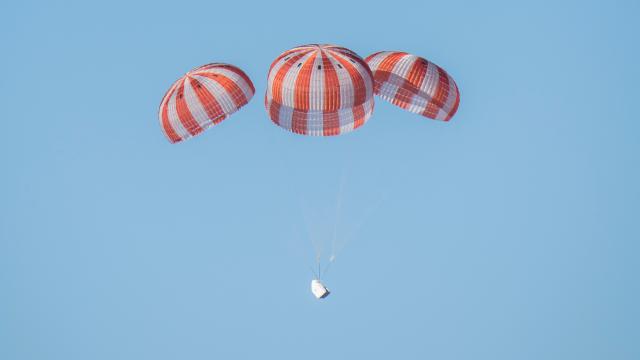A recent parachute test of the SpaceX Crew Dragon capsule “was not satisfactory”, a NASA official said during a House subcommittee hearing yesterday. Few details were disclosed, but it’s now looking even less likely that NASA will have the capability to fly astronauts to space anytime soon.
The House Science, Space, and Technology Committee held a hearing in Washington, DC, yesterday to discuss NASA’s plans to go to the Moon, and how the accelerated lunar timeline might affect the larger goal of sending humans to Mars.
During the meeting, however, the conversation turned to a previously undisclosed incident that happened last month at Nevada’s Delamar Dry Lake during a test of the SpaceX Crew Dragon parachute system.
“The test was not satisfactory,” replied Bill Gerstenmaier, NASA Associate Administrator for Human Exploration and Operations, in response to a question posed by Alabama Congressman Morris Brooks.
“We did not get the results we wanted, but we learned some information that’s going to affect, potentially, future parachute designs,” said Gerstenmaier.
When asked what he meant by unwanted results, the NASA official said the testing apparatus was “damaged upon impact with the ground.”
In an email to Gizmodo, a SpaceX spokesperson confirmed the incident, saying it was an “advanced development test” designed to measure the stresses endured by the parachutes. Rather than use an actual Crew Dragon capsule, however, SpaceX used a simple metal test sled.
During the test, the parachutes didn’t fully open and the sled hit the ground at “a higher than expected velocity,” according to the spokesperson, adding that no one was hurt and no property damage occurred at the test site.
This particular exercise was a “single-out” test, in which one of the four parachutes was deliberately disabled during the descent. The test is meant to simulate a less-than-ideal situation in the event of a single parachute failure.
SpaceX has “successfully performed” five similar single-out parachute tests in the past, according to the SpaceX spokesperson. In this case, however, and as Gerstenmaier explained during yesterday’s hearing, the remaining three parachutes didn’t operate as expected.
As to the cause of the failure, Gerstenmaier was unable to provide an answer.
“We still need to understand whether it was a test setup configuration coming out of the aircraft or if there was something associated with the packing of the parachute, the rigging, all that,” he told the Committee. During the failed test, the loads within each parachute canopy were recorded, and this data will be used during the investigation, he said.
Gerstenmaier said he is “comfortable” that the problem will be resolved and that NASA is “fully engaged” in its efforts to solve the problem. He also tried to cast the incident in a positive light.
“I don’t see this as a negative,” he told the Committee. “This is why we test. This is why we want to push things—this is a gift to us. We’ve gotten data that is unique that will help us design and understand if this is something that needs to be fixed or if it’s something that was a nuance of the test,” said Gerstenmaier.
The SpaceX spokesperson echoed those sentiments, saying the data collected from this anomalous test “provides industry leading insight, informs future testing, and allows us to develop an even safer system.”
To date, SpaceX has completed 19 tests of the parachute system, and there are additional tests planned before NASA sends the capsule to space with an actual crew.
At the hearing yesterday, Patricia Sanders, chair of NASA’s Aerospace Safety and Advisory Panel, told the Committee that a “large number” of parachute tests have been conducted for the Commercial Crew Program in recent months, including for the Orion spacecraft currently under development by NASA and the European Space Agency.
That said, there “have been a few less satisfactory results and some tests that are indicating that there may need to be some redesign or some adjustments made to the design,” she said.
NASA’s Commercial Crew Program, begun in 2010, is a collaboration between the space agency and private partners like SpaceX, Boeing and Blue Origin to develop cheaper transportation to and from orbit.
It appears that SpaceX isn’t the only private firm struggling to develop commercial crew technology, as SpaceFlight Now reports:
Lawmakers did not ask Gerstenmaier about Boeing’s recent parachute test results. But in response to a question from Spaceflight Now after the hearing, he confirmed that Starliner parachute drop tests have encountered anomalies similar to the one suffered by SpaceX last month.
The SpaceX spokesperson did not respond to a question about whether this latest setback might affect the timeline of NASA’s Commercial Crew program. NASA has yet to respond to a Gizmodo query about any potential days stemming from the failed parachute test.
It now seems increasingly unlikely that NASA will be able to conduct crewed tests of the SpaceX capsule in 2019 — especially in consideration of the failed Crew Dragon booster test on April 20, 2019.
[referenced url=”https://gizmodo.com.au/2019/05/yep-that-spacex-crew-capsule-was-definitely-destroyed-during-failed-ground-test-company-confirms/” thumb=”https://i.kinja-img.com/gawker-media/image/upload/t_ku-large/c4qtgcpb9eiqfbgpvtxi.jpg” title=”Yep, That SpaceX Crew Capsule Was Definitely Destroyed During Failed Ground Test, Company Confirms” excerpt=”After weeks of speculation, SpaceX has finally admitted that a Crew Dragon capsule was destroyed during a test of system’s abort thrusters on April 21. No cause was given for the anomaly, nor were any new details disclosed about possible delays to NASA’s languishing Commercial Crew Program.”]
The first crewed test of the spacecraft is supposed to happen on July 25, but that appears overly optimistic given the events of the past several weeks. The U.S. has not had the capacity to independently deliver its astronauts to space since the retirement of the Space Shuttle program in 2011 and has relied on the Russian Soyuz program since that time.
